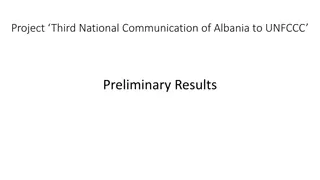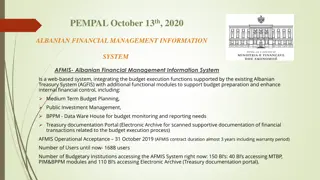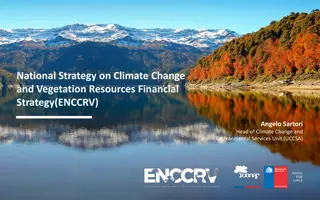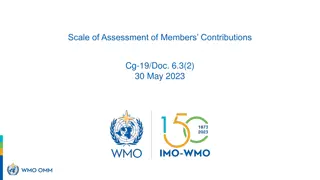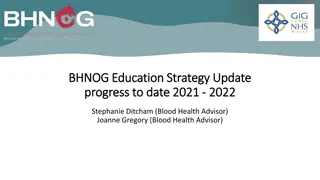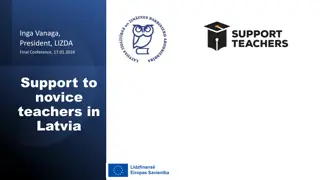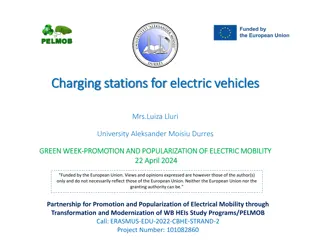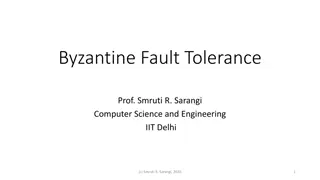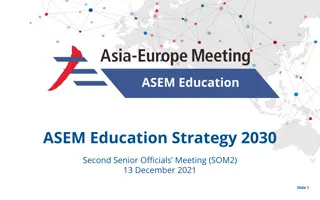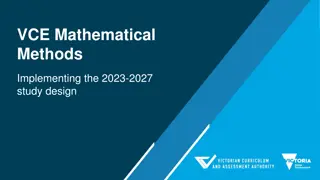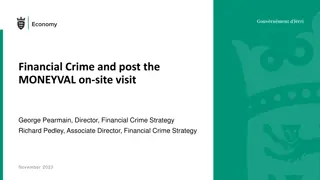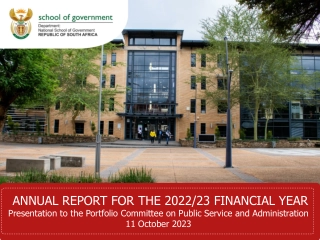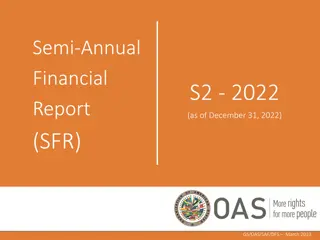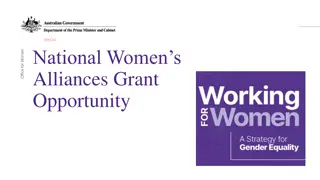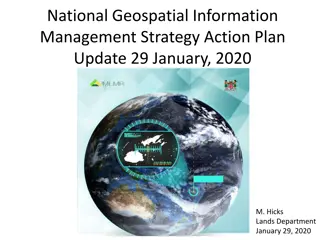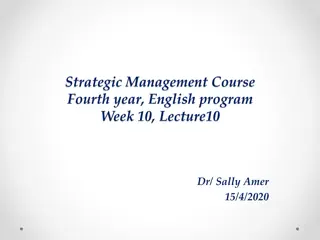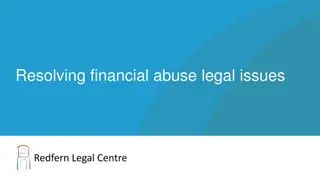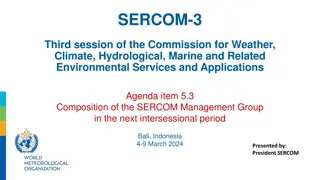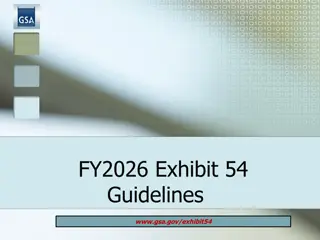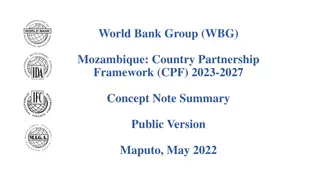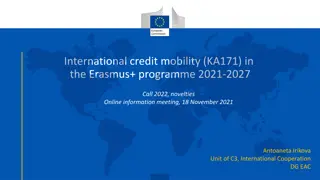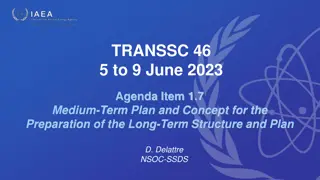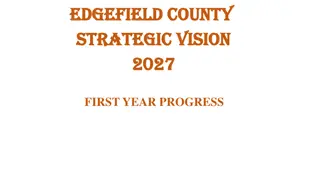Albanian National Financial Education Strategy 2022-2027
The Albanian National Financial Education Strategy (NFES) aims to promote financial education for individuals, households, and MSMEs to enhance financial well-being and economic stability. It focuses on key interventions, foundational enablers, institutional coordination, funding, and monitoring. Financial education, as defined by OECD, empowers consumers to make informed financial decisions. The NFES addresses financial inclusion, stability, and innovation to ensure a competitive and inclusive financial sector.
Download Presentation

Please find below an Image/Link to download the presentation.
The content on the website is provided AS IS for your information and personal use only. It may not be sold, licensed, or shared on other websites without obtaining consent from the author. Download presentation by click this link. If you encounter any issues during the download, it is possible that the publisher has removed the file from their server.
E N D
Presentation Transcript
2022-2027 ALBANIAN NATIONAL FINANCIAL EDUCATION STRATEGY
NFES Context Theory of change Rationale for a National Financial Education Strategy (NFES) NFES structure Market assessment Financial inclusion landscape Financial capability Mapping of exiting financial education efforts CONTENTS NFES Framework Mission, Vision and Strategic objectives Key interventions Foundational enablers Institutional coordination Funding Monitoring and Evaluation
The first comprehensive and institutionally coordinated effort to promote financial education for individuals, households and MSMEs as a key enabler of financial wellbeing and economic stability. ALBANIA NATIONAL FINANCIAL EDUCATION STRATEGY
OECD defines financial education as: the process by which financial consumers/investors improve their understanding of financial products, concepts and risks and, through information, instruction and/or objective advice, develop the skills and confidence to become more aware of financial risks and opportunities, to make informed choices, to know where to go for help, and to take other effective actions to improve their financial well-being . FINANCIAL EDUCATION DEFINED
FINANCIAL EDUCATION THEORY OF CHANGE Inputs Financial Education Intermediate Outcomes Financial Well-Being Long term Outcomes Financial Sector Outcomes Financial education Knowledge, skills & attitudes Behaviors & practices Increased savings Better debt management Effective & appropriate use of financial products Forward financial planning Successful financial negotiations Competitive financial market Savings mobilization Product & channel innovation Financial inclusion Greater consumer protection
RATIONALE FOR A NFES FINANCIAL INCLUSION - Lack of awareness regarding financial products and their benefits and perceived ineligibility/self- exclusion are some of the leading reasons for not seeking formal financial services among the financially excluded. FINANCIAL STABILITY - A lack of understanding of financial products can lead to serious systemic issues in the financial sector, such as over indebtedness, resort to fraudulent informal practices, lack of sustainability and resilience in times of crisis, etc. FINANCIAL INNOVATION - Innovation and sophistication in the financial system and environment, (such as digitalization) provide greater opportunities for individuals and MSMEs, but also pose greater risks.
ALBANIA NFES IN A CONTEXT Knowledge base National Financial Capability Survey (Bank of Albania, 2019) Mapping Exercise of Financial Education Initiatives in Albania (Bank of Albania, 2021) Key informant interviews (Bank of Albania, World Bank, 2021) Albania MSME Finance for Growth Assessment (World Bank, 2018) Achieving Effective Financial Inclusion in Albania: A Payments Perspective (World Bank, 2017) Sector Alignment National Retail Payments Strategy (NRPS) Business Investment and Development Strategy (2021-2027) National Diaspora Strategy (2021-2025)
FINANCIAL CAPABILITY ASSESSMENT On average individuals possess only half of financial knowledge, with a financial literacy index value of 3.7 (out of 7) A little over half of surveyed Albanians report always planning how their money will be spent, and only 42 percent always stick to their plan. Financial behavior: Individuals own less than half (47%) of appropriate financial behaviors. Only a quarter of individuals have the minimum financial behavior (6 out of 9) Financial attitudes: Individuals in Albania possess 64% of the appropriate financial positions More than half of individuals have an index of financial positions as much as the targeted minimum (3 out of 7) Financial well-being: Low levels of financial well-being (7.7 out of 21) indicating that that individuals in Albania are generally insecure about their finances. They limit their choices and are unable to plan ahead. Only 29% of individuals can answer correctly 5 out of 7 questions on financial knowledge, which is the minimum required financial knowledge. A much smaller percentage of adults keep track of their day-to-day spending (26 percent) and those that are banked are more likely to keep exact track as compared to adults that are not formally served. 26% and 11% of individuals can correctly answer questions related to the understanding of the time value of money and the composite interest rate, where only, three times less than the global average Almost all Albanians report having a financial goal (94 percent), such as building or upgrading their home, starting a business or investing in a farm 91 percent of adults mention planning for their children s future as a financial goal. Numeracy & Literacy Planning & Money management Awareness 7
TARGET GROUPS Children and teenagers (age group 6 to 18) Young people (age group 18- 29) Rural population Employed individuals (public or private sector) Adults MSMEs 8
IDENTIFIED CHALLENGES TO PROVIDE FINANCIAL EDUCATION IN ALBANIA Stakeholders are making efforts to coordinate but there is a need for greater leadership in coordinating efforts and tracking progress Need for material commitments from stakeholders to ensure sustainability of activities It is hard to measure the impact of current interventions It is hard for the financially excluded to see and understand the value proposition of financial inclusion Many financial education efforts are not designed based on research of what works 9
NFES COMPONENTS ENSURE THAT ALL ALBANIANS HAVE THE NECESSARY KNOWLEDGE, SKILLS AND TOOLS TO ACCESS AND EFFECTIVELY AND CONFIDENTLY USE FINANCIAL SERVICES TO IMPROVE THEIR FINANCIAL WELL-BEING AND RESILIENCE TO UNEXPECTED EVENTS. 1 2 3 4 5 6 7 Assess the financial education landscape, the needs of the population, areas of programming and current gaps; Identify target populations and priority areas to improve financial education delivery; Establish a sustainable governance mechanism by identifying a lead coordinator to steer and coordinate the collective effort of national financial education delivery; Define specific roles and responsibilities for each stakeholder and propose a process by which stakeholders can maximize their use of available resources. Develop effective education interventions to reach scale and identify sustainable delivery channels for financial education; Provide guidance and support stakeholders to perform their roles and responsibilities through the development of a detailed implementation plan; Provide a structured monitoring and evaluation framework to track progress and ensure effective implementation of the NFES.
NFESFRAMEWORK I. Key drivers Enable proper understanding, access and usage of regulated financial services based on informed decisions. Protect consumers and enterprises from fraudulent practices and innovation risks: Empower underserved client segments, such as financially excluded, rural populations, poor, etc. II. Foundational Enablers Institutional Leadership and Coordination: NFES sponsors drive the implementation and track progress, while other stakeholders contribute based on their mandate and coordinate to share feedback and lessons learned. Customer-centric design: Financial education initiatives should be designed based on thorough assessment of the needs of the target population and in line with research impact models. Alignment with real economy objectives: Designed initiatives should seek alignment and create synergies with other strategic objectives and the sustainable development agenda. 1. 2. 3. 1. 2. 3. 12
KEY INTERVENTIONS Enable understanding, access and usage of regulated financial services based on informed decisions. Basic skills: Promote basic financial skills (financial planning, budgeting and responsible spending) Enable Access: Incentivize greater access to regulated financial services and increase trust by addressing biases and misunderstandings. Usage: Promote effective usage of financial services and products Innovation: Support increased digital access and digital literacy Protect consumers from unfair and fraudulent practices increasing the trust in regulated financial services Ensure effective market conduct measures and support appropriate consumer protection mechanisms Protect Disseminate knowledge about rights, duties and avenues for grievance redressal. Promote fair and ethical industry standards and practices observed in implementing financial education and consumer protection initiatives. Empower vulnerable consumer segments with tailored initiatives Ensure that all population segments are equally equipped with the skills and knowledge regardless of income, personal context, or circumstances. Empower Provide tailored interventions for priority segments, such as youth, rural populations and MSMEs 13
NFES FOUNDATIONAL ENABLERS Institutional leadership and coordination: Define and identify relevant stakeholders Assign stakeholder roles and responsibilities (NFES sponsor, advisory council and working group) Establish principles for collaboration (reporting, funding, decision-making, etc.) Customer-centric design: Identify and understand gaps, needs, contexts, and behavioral outcomes, Pilot, test and evaluate effectiveness of interventions across different audiences Iteratively improve consumer experience and outcomes Measure impact Follow good practices Alignment with real economy objectives: Seek links and synergies with broader national policy priorities or reforms Build partnerships and collaboration amongst the private and public sector 14
INSTITUTIONAL LEADERSHIP AND COORDINATION NFES Leadership: NFES Steering Committee: NFES Advisory Council: Provide policy guidance and implementation oversight, Coordinate stakeholders and relevant committees for both implementation and consultation, knowledge sharing and learning, Coordinate, monitor and evaluate the implementation of the NFES efforts and activities, Deliver or scale programming, and amplify impact, Help ensure programs are aligned to good practice, scaling-up successful financial education programs, Help finalize the NFES and NFES action plans; Provide input into the selection and development of NFES actions over time (annually); Help develop detailed action plans and roadmaps to achieve each action; Coordinate with the regulators on the implementation of actions assigned to each member institution (as needed). Align activities with the best practices and principles laid out in the NFES Periodically report on past and upcoming financial education initiatives Share insights on impact and lessons learned Provide feedback and inputs on the progress and impact of the NFES 15
FUNDING OPTIONS Self-funding. A lead organization funds its own financial education program if it is under its mandate; Private funding: A private sector player might pay for a program from its own, internal resources; Public funding: A public agency or ministry might pay for a program through a budget line item or the reallocation of budgeted funds; Donors: A donor roundtable can be organized for fundraising purposes Pooled funding: A group of organizations pool funds to fund a program: 16
MONITORING AND EVALUATION Data infrastructure Demand-side data to measure and report on the Financial Education Results Framework. Supply-side data, including high-level KPIs or national goals and targets Action-level data collected by programs relevant to financial education actions Action Plan Tracking System Log frame that clearly lays out how the action and program intends to generate outputs that will in turn yield program outcomes. Such outputs and outcomes, which should be reported by implementing institutions or the working groups themselves, can be leveraged as performance indicators to measure progress of the Financial Education strategy. The Financial Education unit will be mandated to develop, maintain and track progress of financial education actions and related programs, and monitor a set of outputs and outcomes to ensure that implementation of financial education actions is on track. Rigorous Testing and Evaluation All financial education program/initiatives should be rigorously tested and evaluated prior to national rollout. BoA and AFSA should promote, coordinate and oversee the integration of rigorous testing or evaluations within financial education programs to assess their impact, share insights and scale up resources for effective financial education programs more efficiently. Reviews Schedule a mid-term review in 2023 Identify new action items and adapt existing ones based on the findings from the mid term review 17


